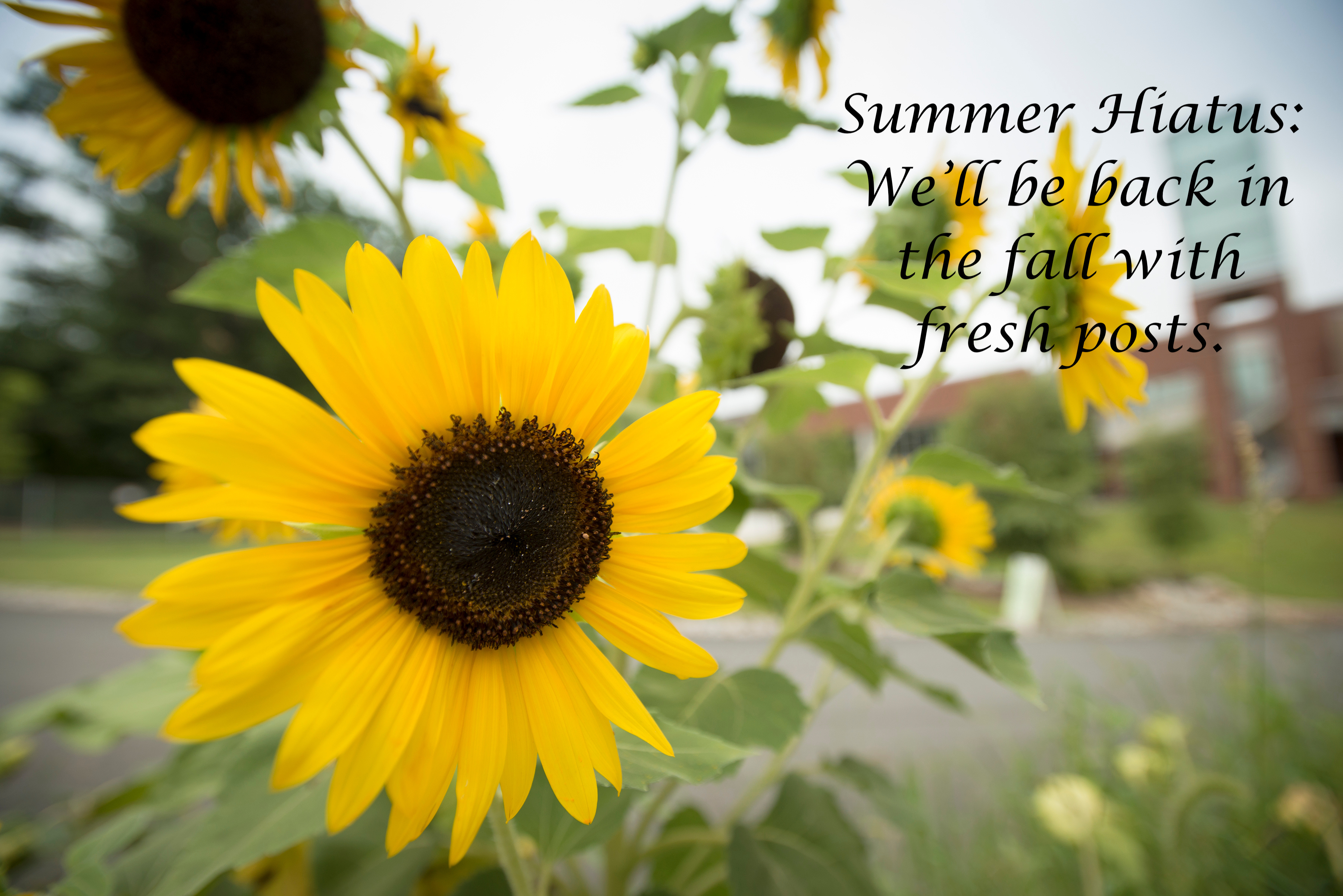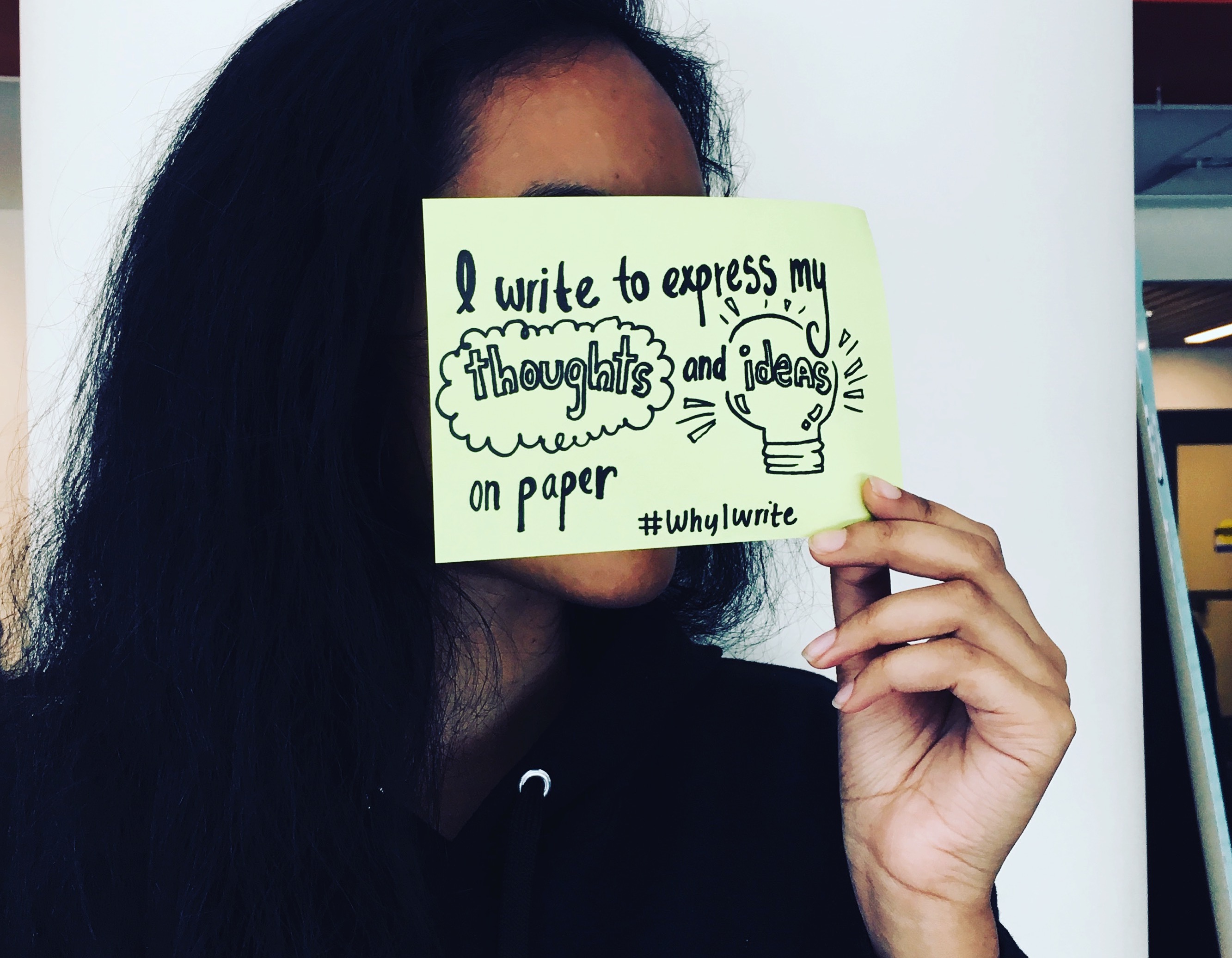
Category: Uncategorized

As we were setting up for the day, we were excited although we weren’t quite sure what to expect. We had researched other campuses’ celebrations, planned with colleagues across campus, purchased a variety of swag, so we were ready to celebrate the National Day on Writing for the first time on Mason’s campus.

Inspired by the season, we here at The Writing Campus would like to thank all of our friends and colleagues who helped us make our first National Day on Writing celebration a success.
In preparation for a new school year, here are our staff blog picks from last year. Read on for four easy-to-use teaching tips for the writing classroom.
Tom Polk, Assistant Director, recommends Mini and Mighty: How the One-Minute Paper can Transform Your Teaching.
In this article, Tom Sura recommends using a simple index card to assess students’ understanding. He uses them at the end of each class to review what students believe was most important and any questions they have.
Tom Polk writes: “what I love about Professor’s Sura strategy is its simplicity. We often think and talk of teaching with writing as an arduous endeavor, but the one-minute paper doesn’t really require planning, time, or technology. It, however, can provide critical insight into our students’ learning while also developing their practice of reflection if used regularly. For professors who are looking for an easy way to start using writing as a pedagogical tool, the one-minute paper is a good place to start.”
Dr. Michelle LaFrance, Director, recommends Error in Student Writing: A Balanced, Developmental Approach:
Paul Corrigan encourages teachers to re-consider their marking of student errors in this piece. By reconsidering their marking, teachers can better encourage and support students’ writing development.
“Paul’s piece reminds instructors that less is sometimes more in dealing with writers at all stages of development—a prospect that is both good pedagogy and time saving for me as an instructor,” comments Michelle.
Alisa Russel, Associate Editor of The Writing Campus, recommends Placing Writing Processes on the Wall:
Here, Donald Gallehr narrates a teaching experience in which he asked students to map out their writing process and THE writing process, thereby helping students re-consider the effectiveness of their process.
“What I love about this piece, whether you follow Dr. Gallehr’s exact activity (which he details nicely for you) or whether you modify it slightly, is that it encourages explicit discussion about writing processes,” explains Alisa. “I think many of our students believe that more experienced or professional writers don’t engage a writing process – that words flow through them from on high. It’s all very mysterious. However, Dr. Gallehr’s activity forces students not only to recognize and name their own processes, but then evaluate them against other models. This way we bring the “grunt-work” of writing out of the mysterious shadows and into the light for our students to better shape their processes – and hopefully produce better papers because of it.”
Emily Chambers, Graduate Research Assistant, recommends Infographics: A Fun, Multimodal Tool for Student Thinking and Writing:
Ben Causey describes how to use infographics and even employs some of his own in this article. Ben outlines ways to use infographics in the writing classroom for pre-writing, revising, or as a stand-alone assignment.
Emily notes that “Ben describes multiple ways to use infographics in the classroom, such that they become accessible and feasible, even alongside a writing assignment or without technology. I’m excited about the ways that infographics can help students compose or revise, as well as helping them improve their technological and visual composition skills.”
When Jessie Stommel tweeted “Start by trusting students. #4wordpedagogy” and invited others to join in making four-word pedagogy statements, he began an unexpected worldwide conversation. More than 4,500 tweets followed, with humorous, provoking, and critical comments on education today. The Twitter conversation Jessie started shows Twitter at its best, as a tool to begin honest conversation and innovation among many.
Many of the tweets are applicable to those who teach writing, though not so specific as to only apply to them. Most of the tweets challenge teachers to rethink the way they approach students:
@Jessifer Learn together, learn forever #4wordpedagogy
— Hoda Mostafa (@hodamost) April 30, 2016
we are all human #4wordpedagogy
— Dr Juliet Ó Brien (@obrienatrix) April 30, 2016
By seeing the humanity of students and the collaborative nature of teaching, teachers are prepared to work with students, not against them; to see students as fellow workers in meaning-making. Still, teachers must acknowledge that they are for students by showing it in words or actions:
@Jessifer I am listening now. #4wordpedagogy
— Dr. Lora Taub (@ltaub) April 30, 2016
https://twitter.com/ProfWCox/status/726975498237038592
The move to acknowledge and show that students matters moves teachers to humility, and makes them able to learn alongside students. In the writing classroom, this can look like writing alongside students, such that teachers can empathize with and build camaraderie with their fellow writers, who also happen to be students. Many who responded to Jessie’s invitation acknowledged that this is just where teachers should be:
@Jessifer Learn together, learn forever #4wordpedagogy
— Hoda Mostafa (@hodamost) April 30, 2016
All pedagogies are co-constructed. #4wordpedagogy
Inspired by a great idea from earlier to have students write 4 word pedagogy statements.
— Jesse Stommel (@Jessifer) April 30, 2016
Nevertheless, this working together can get messy, and others who responded pushed educators to allow students freedom in the messy process of learning:
Leaning can't be "managed" #4wordpedagogy
— martha@[email protected] (@mburtis) April 30, 2016
https://twitter.com/hypervisible/status/726427824161067008
I mess up too. #4wordpedagogy
— Anna Scott (@annascottpiano) April 30, 2016
Others proposed that these messy approaches should be student-centered and experimental:
@Jessifer Give Feedback. Not Grades. #4wordpedagogy
— David Parry (@academicdave) April 30, 2016
https://twitter.com/lesliemb/status/726432611099250688
Provide opportunities to experiment. #4wordpedagogy
— Chris Friend (@chris_friend) May 2, 2016
There’s a beauty to Jessie’s challenge to write a four word pedagogy: it forces educators to zero-in on the core of their pedagogy. As you reflect on the semester past, what are ways that your course adhered to your core pedagogy? What are ways that it got a little off course? Try writing your own #4wordpedagogy, as a way of focusing in on what matters most, then use it to re-evaluate how to move forward in your teaching. We’d love to know what you come up with; comment below or tweet us @writingcampus.
To read Jesse’s full article, visit: https://storify.com/Jessifer/4wordpedagogy
